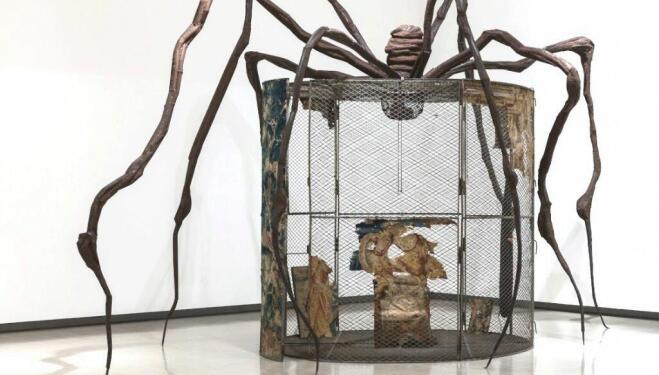
A garden shed complete with tools and an errant coke can has been blown up with explosives and now its fragments hang in a room inside Tate Britain, illuminated by a single lightbulb that casts shadows on the walls as the debris spin in the gentle air currents generated within the gallery. This work by Cornelia Parker is beautiful but also a reminder of the destructive power of our inventions, while at the same time there’s a playful element to it in its title of exploded view referencing both the diagrams used in engineering to show the components of machinery and the fact the explosive Semtex was used to create this work.
It’s one of Parker’s signature works within an excellent survey show, which also includes a circle of musical elements all flattened so they’ve essentially taken their last breath as the spaces within them that used to generate sound have been removed.
Her playful use of material is evident throughout the exhibition with a shotgun sawn into pieces to render it useless, as opposed to shotguns that are often ‘sawn-off’ to make them more lethal, or in twoo abstract works one made using rattlesnake venom and the other the antidote so these are artworks that could literally kill or save us.
Politics features heavily in her work and there’s a lengthy woven version of the Magna Carta’s Wikipedia page, where sections were woven by prisoners recognising that they are imprisoned by the rule of law that this historic document granted to all citizens and also the collective labour that goes into maintaining Wikipedia.
Most haunting is a vivid red room where the walls are covered in the remnant sheets of paper where poppy designs were punched out for Remembrance Day. These ‘cast off’ pieces of paper also ask us to remember the many soldiers who never returned home.
Conceptual art can often be seen as abstruse but Cornelia Parker is able to make it accessible and playful, yet she also adds a level of intelligent rigour to her work that challenges us to think about the wider world we live in. It’s precisely what conceptual art should be.
Cornelia Parker at Tate Britain. 19 May - 16 October, £16.
In May, Tate Britain will launch the first major survey of Cornelia Parker’s works in London. The show will include more that 90 works, including installations, sculptures, film, photography and drawing, stretching back to the 1980s when the artist first rose to prominence.
Parker’s work ranges from the intricate to the colossal, but no matter the scale, her sculptures have a lightness to them - they are never solid lumps of steel or stone. Instead, she breathes air into her works, dismantling and suspending objects that have been steamrolled, deconstructed or seemingly blown apart. There is a playfulness to Parker's sculptures, but also a seriousness underlying much of what she does.
This exhibition will include Cold Dark Matter: An Exploded View 1991, a garden shed frozen at the moment of explosion, its fragments suspended around a lightbulb. There will be installations that fill entire rooms and works that are the product of huge collaborative efforts, such as Magna Carta (An Embroidery) 2015, a thirteen-metre-long hand-embroidered facsimile of a Wikipedia page, which involved over 250 volunteers including public figures, human rights lawyers, politicians and prisoners.
Politics permeates much of Parker’s work and in 2017 she was the first woman to be appointed the official artist for the General Election. The films she made in this role will be go on display in May along other video works, including Chomskian Abstract 2007, an interview with the social critic and philosopher Noam Chomsky.
This is set to be an exciting and thought-provoking exploration of one of the UK’s most celebrated contemporary artists, not to mention one of the biggest exhibitions of the early summer.
| What | Cornelia Parker, Tate Britain review |
| Where | Tate Britain, Millbank, London, SW1P 4RG | MAP |
| Nearest tube | Vauxhall (underground) |
| When |
18 May 22 – 16 Oct 22, 12:00 AM |
| Price | £tbc |
| Website | Click here for more information |
.png)





